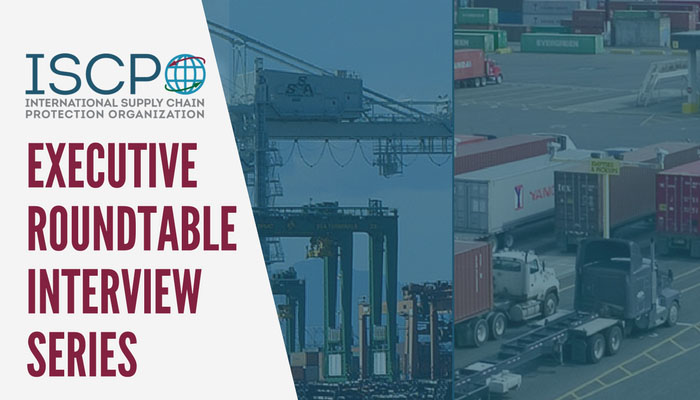As part of our Executive Roundtable Interview Series, we recently sat down with industry thought-leader Aaron Henderson to get his point of view on the challenges, trends, and developments facing the LP / AP industry. We had the privilege to have Aaron on the ISCPO Exploratory Board, where he helped to shape our organization and drive best practices across the supply chain. Aaron is presently Director Loss Prevention at Penske Logistics & Brigade Command Sergeant Major (CSM)/MP Retired.
ISCPO: Please share a short summary of your background and experience in supply chain protection.
I’ve been in the Retail Loss Prevention / Asset Protection sector since 1990. For a large portion of my career, I’ve been responsible for LP primarily for large national retail brands. From 19 90 to 2001, I grew my career and the LP functions at Macy’s and Saks Fifth Avenue. In 2001, I joined Circuit City and was responsible for all loss prevention within the supply chain, which included distribution, logistics, reverse logistics, service centers and e-comm. In 2009, I joined Penske Logistics and was brought in to start a loss prevention department, growing a one-person department to a group of seven. Before and throughout my corporate career, I’ve had the privilege to serve in the US Army on both the active side as well as The National Guard retiring in 2014 as a Brigade Command Sergeant Major. This experience particularly provided me with the required leadership skills to build teams and to articulate the importance of LP at the C-level. It’s also served me well while participating in industry-wide initiatives like the ISCPO.
90 to 2001, I grew my career and the LP functions at Macy’s and Saks Fifth Avenue. In 2001, I joined Circuit City and was responsible for all loss prevention within the supply chain, which included distribution, logistics, reverse logistics, service centers and e-comm. In 2009, I joined Penske Logistics and was brought in to start a loss prevention department, growing a one-person department to a group of seven. Before and throughout my corporate career, I’ve had the privilege to serve in the US Army on both the active side as well as The National Guard retiring in 2014 as a Brigade Command Sergeant Major. This experience particularly provided me with the required leadership skills to build teams and to articulate the importance of LP at the C-level. It’s also served me well while participating in industry-wide initiatives like the ISCPO.
ISCPO: How has the industry evolved since you started out?
When I first started out, most people, including myself, started on the retail side of the business. Reacting to retail theft was the main part of my job but I quickly got exposed to supply chain management, taking on added responsibilities regarding safety and protection – from developing standards that secure cargo/distribution and maintaining supply chain protection, to dealing with employee safety and workplace violence. Companies now recognize the importance of maintaining security and protection processes, both internally and externally as it affects all areas of the organization.
Two areas that I’ve seen change immensely are:
TECHNOLOGY – Everyone will tell you that tech continues to grow and evolve over time; something new today is outdated in 12 months or sooner with the next best thing. For example, monitoring has come a long way. VHS tape analog cameras evolved into digital video recorders and now CCTV cameras have the capability to record digital footage thru IP so we can look at an area via a mobile device in real-time, anywhere. Biometrics is starting to become standard process with swipe cards being replaced with thumbprint technology, which cuts down on fraud or enables a lock down in an instant.
The big challenge is balancing ROI and staying up to date. I’ve found that it helps to look at technology from an organizational standpoint and how it can improve processes within other areas of the business. For example, a camera system obviously is a must-have from a security standpoint; but, it also can be used by marketing to analyze end-consumer foot traffic or by management to monitor staff productivity or safety.
C-SUITE SUPPORT – Another area I’ve seen a shift is at the C-Suite level. I have seen over the years that the C-Suite now understands the value that a LP /AP team brings to the table. Security touches so many aspects of the business today that we didn’t see 10 to 15 years ago. A dedicated LP/AP team can save a company money in the long run. And, leaders are taking external factors very seriously. For example, protection of staff is a priority. There need to be programs in place for every contingency such as active shooter protocols or dealing with situations within the community, like protests, that can disrupt your supply chain.
ISCPO: What are the three most important elements a company must do to maintain a high standard of supply chain protection?
- Maintaining a ‘Being Aware’ mind-set: It’s important to always think about how a company’s environment or how every business decision or process can be affected from a security or protection point-of-view. Always stay on top of the industry trends that effect your business-from technology advances to cargo theft trends. A leader must be aware of their environment and how to communicate standards effectively, especially if you have several locations. For example, Los Angeles is known for cargo theft, so it’s vital for staff to be aware by following security protocol and mitigating exposure. Or, if there’s a business disruption, such as a protest, cargo should be re-routed to keep drivers safe and to protect the cargo.
- Inventory Control: You must have strong inventory control programs implemented within your supply chain. Maintaining accurate inventory is key to success from the minute you receive it in the door from your supplier to the moment the end customer receives it. We play a big role in trying to shrink the window of inventory sitting on the books, which is tied to training, warehouse management systems, and the enterprise system itself.
- Security: Security is prevention in its simplest form. It’s your job to evaluate, implement, and monitor the best security plans and systems across the entire business and the industry you work in. Ultimately, by establishing the proper security across all departments of a business you’re protecting your brand, protecting your product and most importantly protecting your people.
ISCPO: What is THE biggest challenge to supply chain protection & security, from a holistic industry level?
Speed. Everyone is trying to beat the competition with getting product to the store/customer in the fastest, most cost-effective way possible. Customers today order online and want the product that day. The speed of LP needs to be faster, not merely keeping up with the speed of the business. We need to anticipate and be one step ahead of the next link in the supply chain. Any weak links slow down the chain and increase risk which could impact shrink.
ISCPO: Why did you participate on the ISCPO exploratory board and what do you get out of being an ISCPO member?
I joined the board because I see the value the ISCPO brings to the industry. Within my own [retail] industry we have several organizations, but most focus on the retail environment. I would attend conferences that had little to do with supply chain management.
In my industry, the first step in preventing shrinkage and improving the customer experience is to make sure that the product makes it from the DC / Vendor to the store or customer, so you have to get it right, every time. Within the industry, we have several challenges on the supply chain side of the business. We need groups like the ISCPO to facilitate networking where Supply Chain LP practitioners can get educated on best practices as well as share knowledge and problem-solve.
It pays to participate in these kinds of organizations. During my time at Circuit City, I reached out to my LP counterpart at my #1 competitor. We both were dealing with the same industry trends and organizational issues. By sharing knowledge, we were essentially creating our own industry best practices. That’s where the ISCPO comes in.
As an ISCPO member, I’ve met colleagues to discuss potential solutions, vendor options, and to get the latest trends. Lately, I’ve used my ISCPO connections to expand my knowledge on international issues, given my global mandate at Penske Logistics. With any professional organization, it’s the opportunity to network that’s priceless. It’s education too. When I went to ISCPO’s 2016 conference I met a lot of people and vendors that sparked new ideas plus hearing about cases on a federal level that affect my business. Having this knowledge and bringing it home to my team, and my C-level executives enable me and my organization to stay current.

